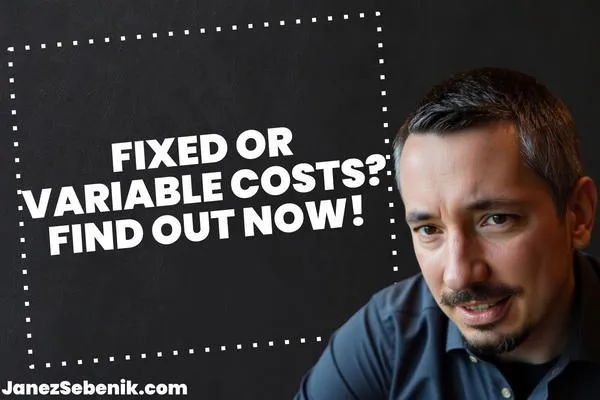
Do companies prefer fixed or variable costs?
Companies face a big choice: fixed or variable costs? It's like picking between a safe bet and a wild card. You pay fixed costs no matter what, while variable costs change with your sales.
Most companies prefer a mix of both fixed and variable costs to balance stability and flexibility. This combo helps them stay nimble when times are tough and cash in when business is booming.
Think of it like this: fixed costs are your rent, while variable costs are your grocery bill. You need a place to live, but you can adjust how much you spend on food. Smart businesses find the right balance to keep their wallets happy and their options open.
Key Takeaways
Companies usually prefer a mix of fixed and variable costs for balance
Fixed costs provide stability while variable costs offer flexibility
The ideal cost structure depends on the business type and market conditions
Understanding Cost Structures
Companies deal with different types of costs. Knowing these costs helps them make smart money choices. Let's break it down for you.
Defining Fixed and Variable Costs
Fixed costs stay the same no matter what. Think rent, salaries, and insurance. They're like your Netflix subscription - you pay the same whether you binge-watch or not.
Variable costs? They're the party animals. They change based on how much you produce or sell. More sales = more costs. Less sales = less costs. Simple, right?
Examples of fixed costs: • Office rent • Equipment leases • Insurance premiums
Examples of variable costs: • Raw materials • Packaging • Sales commissions
Hybrid Approach: Semi-Variable Costs
Sometimes, costs like to play both sides. Enter semi-variable costs. They're part fixed, part variable.
Think of your phone bill. You've got a fixed monthly fee, but extra charges if you go over your data limit. That's semi-variable for you.
Other examples: • Utilities (base rate + usage) • Salaries with commissions • Machine maintenance
These costs give businesses some wiggle room. They can adjust spending based on how busy they are.
The Importance of Sales Volume
Sales volume is the puppet master of your profit margins. It pulls the strings of your costs and revenue.
With fixed costs, more sales mean lower cost per unit. Your rent stays the same whether you sell 10 or 1000 items. Spread that cost over more sales, and each item costs you less.
Variable costs are trickier. They go up with sales, but usually at a slower rate. This can boost your profits as you sell more.
The sweet spot? That's when your sales volume covers all costs and leaves you with a nice profit. It's like finding the perfect balance on a seesaw.
Fixed Costs in Detail
Fixed costs are expenses that stay the same no matter how much you produce. They're like the rent you pay for your apartment - it doesn't change whether you're home all day or never there.
Common Fixed Costs
Let's talk about the usual suspects in the fixed cost lineup:
Rent: The money you shell out for your business space.
Insurance: Gotta protect your stuff, right?
Salaries: Your full-time employees' paychecks.
Depreciation: When your equipment loses value over time.
Amortization: Spreading out the cost of intangible assets.
These costs stick around even if you're not making a dime. They're like that friend who always shows up at dinner, whether you invited them or not.
Fixed Costs and Economies of Scale
Here's where things get interesting. As you grow, your fixed costs don't change much. But your output? That can skyrocket.
Think about it:
Your rent stays the same whether you make 10 widgets or 10,000.
More production = lower cost per unit.
This is what we call economies of scale. It's like buying in bulk at Costco - the more you buy, the cheaper each item gets.
As you ramp up production, your fixed costs get spread out. Your cost per unit drops. Suddenly, you're making more money on each sale.
Accounting for Fixed Costs
Now, let's talk about how these costs show up in your books.
On your income statement:
Fixed costs are part of your overhead expenses.
They're usually listed separately from variable costs.
On your balance sheet:
Some fixed assets (like equipment) show up here.
Their value decreases over time due to depreciation.
When you're doing your accounting, keep an eye on these fixed costs. They can make or break your profit margins, especially when sales are slow.
Remember, just because they're fixed doesn't mean you can't negotiate them. Always be on the lookout for ways to trim these expenses. Every dollar saved goes straight to your bottom line.
Variable Costs in Action
Variable costs change based on how much a company produces or sells. They're like a business's flexible spending that goes up or down with activity.
Variable Costs and Business Activity
You know those costs that bob up and down like a yo-yo? That's variable costs for you. Think direct materials and labor - they're the real MVPs here.
When you're cranking out more products, you'll need more raw materials. More sales? Expect those commissions to skyrocket.
It's like a seesaw. More action = higher costs. Less action = lower costs. Simple, right?
Here's a quick breakdown:
Materials: More products = more stuff to make 'em
Labor: Busy times = more hands on deck
Commissions: More sales = fatter wallets for your salespeople
Tracking Variable Costs
Keeping tabs on these costs is crucial. It's like counting calories, but for your business's wallet.
You've got to stay on top of your game. Use accounting software to track every penny. It's your secret weapon for nailing those financial statements.
Pro tip: Break down your costs per unit. It'll give you a clear picture of what's eating into your profits.
Remember, knowledge is power. The more you know about your variable costs, the better you can control them.
Managing Variable Costs
Now, let's talk strategy. Managing variable costs is like playing chess with your business finances.
First up, negotiate like a boss. Get better deals on materials. It's amazing what a good chat with suppliers can do.
Next, optimize your processes. Streamline production to cut down on labor costs. Work smarter, not harder.
And don't forget about pricing. Use your variable cost data to set prices that'll keep you in the green.
Lastly, keep an eye on that cash flow. Variable costs can be unpredictable, so always have a cash cushion ready.
Cost Calculation and Management
Knowing your costs is key to making money. Let's dive into some ways you can crunch those numbers and boost your profits.
Break-Even Analysis
Ever wonder how many sales you need to cover your costs? That's where break-even analysis comes in. It's like finding your business's sweet spot.
You take your fixed costs and divide them by your profit per unit. Boom! That's your break-even point.
For example, if your fixed costs are $10,000 and you make $50 profit per widget, you need to sell 200 widgets to break even. After that, it's all gravy.
This tool helps you set prices, plan production, and make smart decisions about your business. It's like having a financial crystal ball.
Cutting Costs for Profit
Want to fatten up your bottom line? Time to trim the fat from your expenses. But be smart about it.
Start by looking at your variable costs. Can you negotiate better deals with suppliers? Maybe bulk buying could save you some cash.
Don't forget about those sneaky fixed costs. Can you find a cheaper office space? Or maybe go remote and ditch the rent altogether?
Remember, cutting costs is great, but not if it hurts your product quality or customer service. It's a balancing act.
Financial Planning and Forecasting
Want to steer your business to success? You need a financial roadmap. That's where planning and forecasting come in.
Start by looking at your past performance. What trends do you see? Use these to predict future sales and costs.
Create a budget. It's like a game plan for your money. Set targets for revenue and expenses. Then track how you're doing against these goals.
Don't forget about cash flow. It's the lifeblood of your business. Plan for when money comes in and goes out. This helps you avoid cash crunches.
Remember, plans aren't set in stone. Be ready to adjust as things change. It's all about staying flexible and keeping your eyes on the prize.
Real-World Examples
Companies grapple with fixed and variable costs every day. Let's look at how different industries handle this and how they adapt to changing markets.
Examples From Various Industries
Ever wonder how Netflix keeps its costs down? They use a lot of fixed costs. Their main expenses are content creation and tech infrastructure. These don't change much, no matter how many people watch.
On the flip side, think about Uber. Their costs are mostly variable. Driver payments and fuel costs change based on how many rides people take.
Retailers like Walmart? They're a mix. They have fixed costs like rent, but their inventory costs change with sales. It's a balancing act.
Manufacturing companies often lean towards fixed costs. They invest in expensive machinery. But they also have variable costs like raw materials and labor.
Adapting Cost Structures to Market Conditions
Smart companies know how to dance with the market. When times are tough, they might cut variable costs first. Reducing production supplies is easier than breaking a lease, right?
During boom times, they might ramp up variable costs. More sales mean more credit card fees and shipping costs. But they can handle it because revenue is up.
Some businesses get creative. They turn fixed costs into variable ones. Think about companies using cloud services instead of buying servers. It's genius!
Others do the opposite. They might buy their delivery trucks instead of renting. It's a gamble, but it can pay off if they're confident about future demand.
